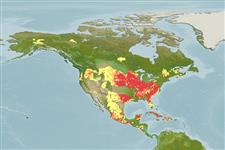| Native range | All suitable habitat |

|
| This map was computer-generated and has not yet been reviewed. |
| Ictalurus punctatus AquaMaps Data sources: GBIF OBIS |
Length at first maturity
Lm 36.0 range ? - ? cm
Human uses
Fisheries: highly commercial; aquaculture: commercial; gamefish: yes; aquarium: commercial
Phylogenetic diversity index
(Ref. 82805)
PD50 = 0.5010 many relatives (e.g. carps) 0.5 - 2.0 few relatives (e.g. lungfishes)
Trophic Level
(Ref. 69278)
4.2 ±0.3 se; Based on diet studies.
Resilience
(Ref. 69278)
Low, minimum population doubling time 4.5 - 14 years (K=0.06; tmax=16)